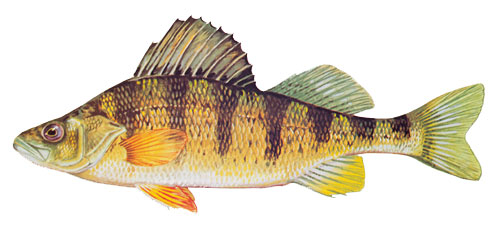| Yellow Perch |  |
Yellow Perch | | Perca flavescens | (A.K.A. - Yellow ned, Ned)
| Key Distinguishing Markings:
- The general coloring of yellow perch tends to be brassy green to golden yellow on their sides and white to yellow on their belly.
- Their most distinguishing feature is 6-8 dark vertical bands found across their back and sides.
- Their anal, pelvic, and pectoral fins are red to orange, with these colors being brightest in males during the spawning season.
- These fish are also characterized by having a dorsal fin that is completely divided into a spiny portion and a separate soft-rayed portion.
- Their anal fin features two long and slender spines.
- The body is elongate and moderately compressed.
- The mouth large and terminal (the upper and lower jaws form the extreme anterior of the head).
View the Yellow Perch Gallery
| Distribution:
- On the Atlantic coast, yellow perch range from South Carolina north to Nova Scotia.
- They can also be found west through the southern Hudson Bay region to Saskatchewan, and south to the northern half of the Mississippi drainage.
- Yellow perch are generally freshwater fish and can be found in all Maryland reservoirs, including Piney Run, Liberty, Loch Raven, and Prettyboy Reservoirs.
- However, in Maryland, yellow perch have adapted to the estuarine waters of Chesapeake Bay and have historically been reported in all of its major tributaries and streams.
| Size:
- Yellow perch can reach a maximum size of 18 inches.
| Habitat:
- Adult yellow perch inhabit slow-moving, nearshore areas where moderate amounts of vegetation provide cover, food and protection.
- Larval yellow perch will remain in the tributaries, but will generally migrate offshore to reduce their risk from predators.
- As juveniles, they move back to the shorelines to feed on the richer, nearshore food sources; at this stage, predator avoidance has been sufficiently developed.
| Spawning:
- In Chesapeake Bay, adult yellow perch migrate from the lower parts of the tributaries to the upper regions in search of suitable spawning habitat from late February in the Chesapeake Bay region to April in Deep Creek Lake.
- Adults migrate shoreward into the shallows of impoundments and often into tributary streams to spawn.
- When they occur in brackish waters, males tend to reach the freshwater spawning areas first and do not migrate downstream until the females leave.
- When females arrive, they lay their eggs in large gelatinous strands, usually suspended from some type of structure or organic debris, which are then fertilized by multiple males.
- Hatching occurs 11-27 days after fertilization, depending on water temperature.
- Males reach sexual maturity between ages 1 and 3.
- Female yellow perch mature between ages 2 and 3 and can produce between 5,000 and 109,000 eggs.
- Yellow perch are known to live as long as 13 years.

| Fishing Tips:
- Recreational fishing for yellow perch is a very significant fishery in Maryland and has become a tradition for many anglers as the first fish to "arrive" in the rivers after the first of the year.
- Most fish are caught in these early winter months during their spawning run in the upper tributaries where they are easier to catch.
- Yellow perch are an important sportfish in Maryland, especially in the Chesapeake Bay area and Deep Creek Lake, because they inhabit a vast territory, a wide variety of habitats, are a schooling fish, and congregate near shore in the spring.
- They are also taken recreationally mainly because of their flavor and their desire to take a baited hook.
- For current recreational size and creel limits, see Maryland's updated regulation page.

| Fun Fact:
- The largest yellow perch recorded in Maryland was caught in a Harford County farm pond in 2003 and weighed 3 lbs., 5 oz.
- Their method of spawning is unique in that female yellow perch lay their eggs in long gelatinous strands, usually floating or hanging from vegetation or some other structure.
- Yellow perch are found in approximately 13,000 acres of lakes and ponds, with tributaries to Chesapeake Bay furnishing considerably more water area.
| | Family: Percidae (Perches) | | Order: Perciformes (perch-likes) | | Class: Actinopterygii (ray-finned fishes) | For information concerning yellow perch and their management, please contact Paul Piavis.
Illustration courtesy of Duane Raver, USFWS |
|
